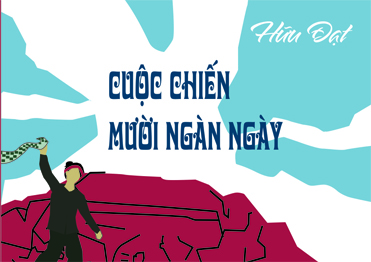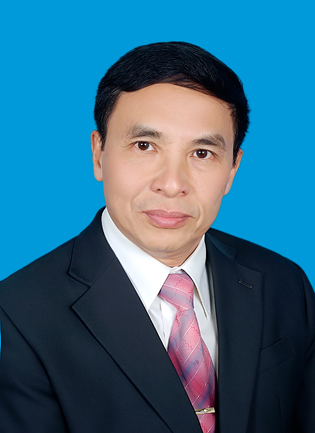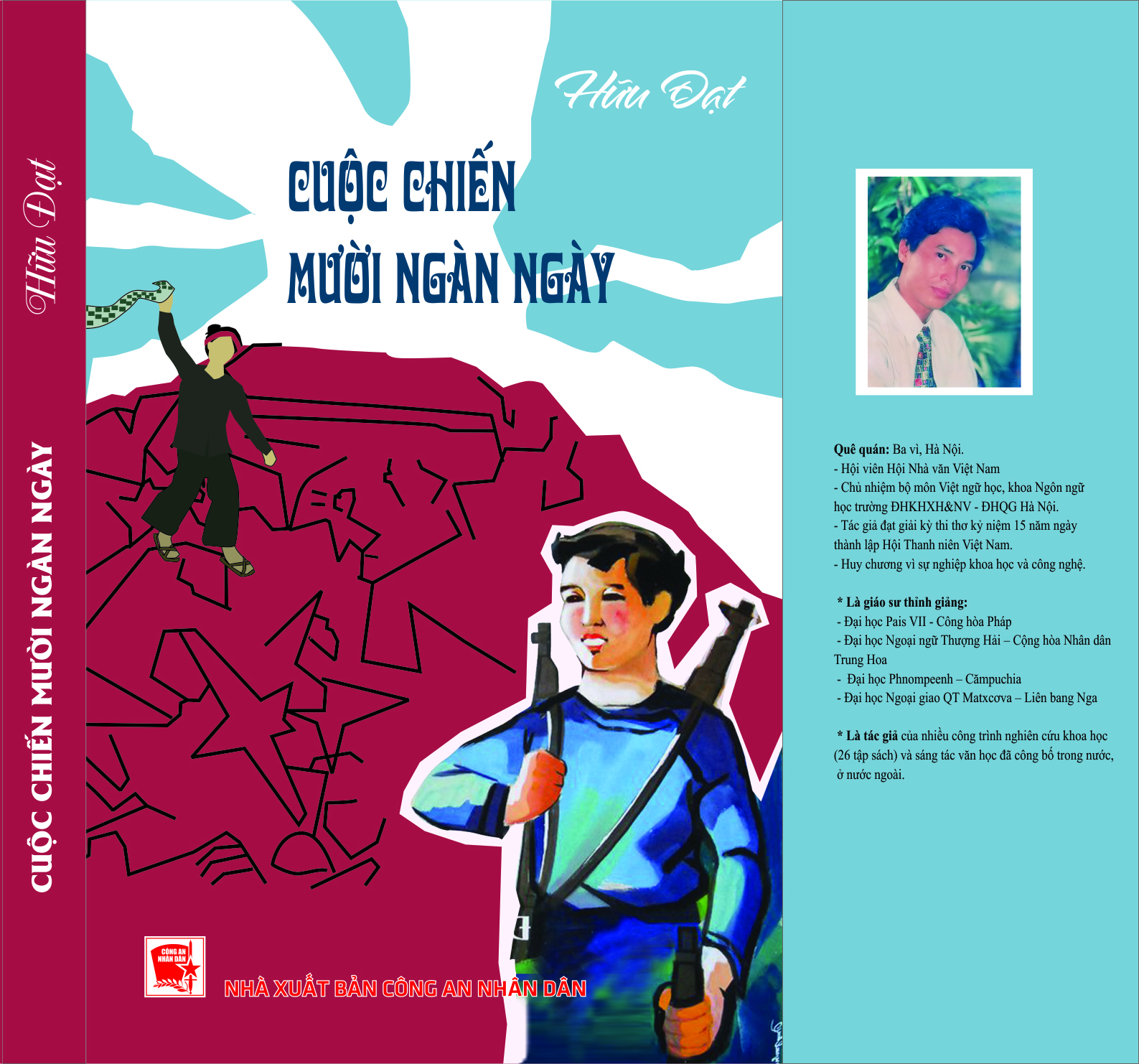

HISTORY AND LITERATURE
History is not literature. Of course. But in a certain context, history and literature coincide, support each other, respond to each other and illuminate each other. Take an example in contemporary literature to make it closer and easier to remember. The historical campaign of Dien Bien Phu ended "with a red wreath and a golden history" (To Huu) was quickly fictionalized throughPeople layer upon layer(1955) by Tran Dan,The final climax(1960) by Huu Mai. The Ho Chi Minh campaign and our total victory in 1975 were recreated in the novels of Khuat Quang Thuy (In the whirlwind, 1977), Nguyen Tri Huan (In 1975 they lived like that, 1979). Most notable is the documentary novelWar Records 1-2-3-4.75(2014) by journalist Tran Mai Hanh writes about the historic Ho Chi Minh campaign and the end of the world, the collapse of the Republic of Vietnam government. This work brought glory to the author with two prestigious literary awards (Vietnam Writers Association Award 2014, Southeast Asia Literature Award, 2015). The book was reprinted many times, with a total of 10,000 copies (a dream number for writers today). Some major campaigns during the war were also fictionalized such asSoldier's Footprintsby Nguyen Minh Chau (about the Route 9 - Khe Sanh campaign),Thuong Ducby Nguyen Bao - Truong Giang (about the Thuong Duc campaign), etc. and etc. A phenomenon that cannot be ignored when talking about the relationship between history and literature is the fact that the National Political Publishing House - Truth printed the entire 17 volumes (with 9,000 printed pages) of the epic documentary novel seriesTime lineby author Dang Dinh Loan. The book series recreates the resistance war against the US to save the country of the Vietnamese people on the historical journey from 1954 to 1975. The highlight of this novel series is its "panoramic" nature (describing the war both in the trenches and at the headquarters, both macro and micro). The fictional part as a novel is of course immature. But the abundance of materials has given the book a panoramic nature ("panorama”) is essential to literary works about Revolution and just war.
Looking at the field of poetry, we can see the historical imprint very clearly - that is, Revolution and war are recreated through poetic language, through the specific genres that are the main force of poetry - long poems, epics. These are works that cannot be ignored when imagining the history of modern literature since 1945 such asThirty years of our life with the Partyby To Huu,Song of the Birdsof Thu BonThe road of desireNguyen Khoa Diem,Epic of the Divisionby Nguyen Duc Mau,The land of lightningby Tran Manh Hao,Footprints on the grasslandby Thanh Thao,Cast a shadow on the sunby Tran Anh Thai,Road to the cityAccording to the statistics of author Do Quyen, up to now there are a total of 150 Vietnamese epic poems written about modern times in the changes of revolution and war.
ANOTHER REVOLUTIONARY SONG
We have seenA history on televisionproduced by American filmmakers, about the Vietnam War. Documents and documents. But the Americans breathed life into the documents. From that inspiration I want to callThe Ten Thousand Day Warby writer Huu Dat is "a history in verse".
But writing a long poem requires a prerequisite - you must have…a strong foundation (different from writing a quatrain, a six-eight meter, or a seven-word eight-line meter). If we compare, a long poem writer must have a wealth of capital like a writer of a thousand-page novel, not a short story of five or at most a few dozen pages. If you have known writer Huu Dat for a long time like us, you will see that he has been persistent in building a literary career since the seventies and eighties of the last century. It can be said that after decades of struggling to live and write, writer Huu Dat has experienced and accumulated a full foundation of capital. He spreads that capital to use for drama, poetry, literature, and literary research and criticism. But writing a long poem, as mentioned above, requires a strong foundation. Granted. But is it direct or indirect life capital? Both. This can be affirmed through the case of writer Huu Dat. But many people with great strength still cannot “catch on” or “get along” with this “heavy artillery” genre of literature – epic poems. Why? Because they lack a fundamental element – great inspiration. We call it “literary spirit”. It must have the spirit of an eagle, not a sparrow (although if grilled and eaten, sparrow meat would be more delicious!). In a recent article,Where does poetry go?? We have explained the impasse of contemporary poetry (especially young poetry) mainly because of the lack of great inspiration of humanism. Today's poetry is less oriented towards humanity, only focusing on digging up the small and selfish ego when completely detached from the self. All superficial pain, sadness, forced joy. As poet Huu Thinh said, young poetry is good at "embroidery" for itself but bad at "sewing" for others!

EpicThe Ten Thousand Day Warby writer Huu Dat belongs to the mainstream literature, written with a great inspiration of "literary atmosphere". Of course. It must be added that, writing an epic poem requires the qualities of a conductor, not just a musician. The role of the conductor is shown in the process of organizing the structure, we consider this the first breakthrough and the final completion when successfully creating an epic poem of such stature and meaning.The Ten Thousand Day War. Although structure is a formal element as the theory of artistic thinking has pointed out. But in art, form and content are like two sides of a sheet of paper. Characteristics of the structure of an epic poemThe Ten Thousand Day WarWhat is it? Let's call it a "thematic medley". If we look at the content of the 12 chapters of the epic poem, we will clearly see this characteristic - the order of the chapters: "Autumn Aspiration/ 9-year resistance/ Dien Bien Phu/ When we grow up/ Historical confrontation/ Mothers/ University/ Villages/ The last battle/ The country changes/ Challenge/ Our generation". And how to bind the 12 chapters, with what "glue"? It is impossible to use purely formal elements to bind the parts/components of the epic poem. There needs to be a main idea running through it like a "red thread". I think the "red thread" running through it is "Autumn Aspiration" (as the name of Chapter One). The aspiration for independence and freedom for the entire nation ("Nothing is more precious than Independence and Freedom" as President Ho's call). The most honest saying of Bao Dai, the last King of the Vietnamese feudal regime: Being a citizen of an independent country is happier than being the king of a slave country. Said during the abdication, handing over the seal and sword to the revolutionary government, in 1945. The aspiration for independence and freedom is even more burning today when the East Sea is raging, when "The Fatherland is seen from the sea". The postulate of the great Russian writer M. Gorky is never old: "A heroic age requires a heroic art". Long poemThe Ten Thousand Day Warby writer Huu Dat, it can be said, belongs to the "heroic art" genre.
ARTISTIC EXPERIMENTS
Art accepts exploration and experimentation even if it fails. There must be an open and generous view in the field of artistic creation. But it must be said right away that the exploration of some recent "poetry groups" (such as the Heavenly Horse Group, or Open Mouth) is clearly unacceptable because it deviates from the orbit of Truth - Goodness - Beauty. Recently, poet Tran Quang Quy experimented with 5-line poetry (his latest collection of poems is titlednamkau),warmly welcomed by readers. Is Vietnamese five-line poetry as good as two-line poetry?haikuJapan or not still need time to clarify.
Let's see how writer Huu Dat experiments with the art of poetry in his epic poem.The Ten Thousand Days War.First of all, in this epic poem, the author minimizes “narration”. Because if he falls into narrative, the work will turn into a “long poem” and not an “epic poem”. But perhaps the author mainly focuses on designing a type of poetry called “pictorial poetry”. In the previous collection of poemsTravel(2014) writer Huu Dat has begun to experiment with this type of pictorial poetry. But it must be said that he is still cautious, not really confident. It is only exploratory. To the long poemThe Ten Thousand Day War, writer Huu Dat is more confident and pushes pictorial poetry to the first level with the awareness of new forms carrying traditional content (new bottle, old wine!?). Pictorial poetry, according to the author's statement, is not simply a "language game", but aesthetic information. Secret "meanings", implying philosophy of life. How many pictorial images are there in this epic poem? There are images of a communal house roof, a bronze drum, a bronze censer, an ancient vase, a haystack, a jar,... Many, many.
As an experienced reader, I share with writer Huu Dat the main idea of the epic: “With those symbols and hidden meanings to reveal that this war is a confrontation between two cultures. In which, Vietnam is a country with a long-standing culture that has won over the pragmatic culture with modern American-style means and weapons”. So, in my opinion, it is necessary to accept the epicThe Ten Thousand Day Warof writer Huu Dat from the cultural perspective. Thus, we will have a view of the author's open creative range. Putting the literary category in the cultural category, we will see more clearly the path and writing style of each writer. This is because the culture of writers is currently a very topical issue (while the education of writers is clearly raised, the culture of writers is at risk of decreasing, why?!).
I want to talk about the behavior of writer Huu Dat with Vietnamese (when behavior is one of the basic qualities that evaluates a person's cultural foundation). Don't think that a literature teacher, a linguist when writing will be "perfectly perfect" in their mother tongue - Vietnamese. I don't think that writer Huu Dat, the current Head of the Department of Vietnamese Linguistics (Faculty of Linguistics, University of Social Sciences and Humanities), will have everything about words and phrases completely smooth. There are currently nearly 300 writers who used to be, are teachers. But as far as I know, the words and phrases are still not perfect. I randomly extractedChapter Sixin the epicThe Ten Thousand Day War-Mothersto illuminate the writer Huu Dat's treatment of the Vietnamese language. Our greatest Mother, who gave birth to us, isMother Au Co!But that is a legend. There is a boundless spiritual Mother entity that isVietnamese Mother. But that is also in the spirit. In real life, we have other mothers, ordinary but great: “Mothers who create the bronze drum dance/Their hearts are as calm and gentle as rice stalks/When the enemy comes in the night, they are in labor/Still dignified in the posture of a master”. And more: “Mothers who have worked hard for four thousand years/Each drop of sweat contributes to the pages of history/Without words, they use leaves to create words/Folk songs are passed down forever”. When writing about Mothers, one cannot help but conclude: “Every inch of land is a drop of blood/Each life is how many tears/Mothers' backs bend to carry the two ends of the country/For a strip of mountains and rivers in the shape of the S”. It is observed that the writer uses many verbs when writing about Mothers (giving birth, giving birth, carrying, making, dancing, giving birth, contributing, passing down by word of mouth, carrying, holding a sword, singing, raising children, dreaming, laughing, wandering, swaying, transforming,...). And not onlyChapter Six. The whole epic is filled with verbs. Verbs create the atmosphere of the times: “one day is equal to twenty years”, “Revolution is a festival of the masses”. Verbs contribute to the rhythm (rhythm) of the epic. A seething, urgent, and fierce rhythm. And moving forward. This is a concise, moving chapter with echoes.Chapter Sixended with haunting verses: “Oh Fatherland! A thousand years without mother/Where are the poets and heroes? Mother - the support for her children/For the country/Your thin body has transformed into the shape of mountains and rivers.” If we say “literature is the art of language,” then when reading the long poemThe Ten Thousand Day WarWriter Huu Dat cannot help but pay attention to this important aspect.
CONCLUSION
Someone rightly said: "It is not the historian, but the writer who writes the history of life".Travel(2014) still deeply lyrical, but it is an individual self, with a hint of loneliness in the world, toThe Ten Thousand Day Waris a "transformation". Magnificent, heroic, panoramic, literary atmosphere, as the qualities of the work, if one can say, is the "peak" in the literary legacy of writer Huu Dat. He has composed dozens of works of all genres (drama, poetry, short stories, novels). But in my opinion, the epic poemThe Ten Thousand Day Warjust revealed the writer's writing power and talent. Maybe my opinion is not the same as many others when reading writer Huu Dat's writing. I have to accept it./.
Hanoi, December 2016
Writer Bui Viet Thang
Author:Writer Bui Viet Thang
Newer news
Older news